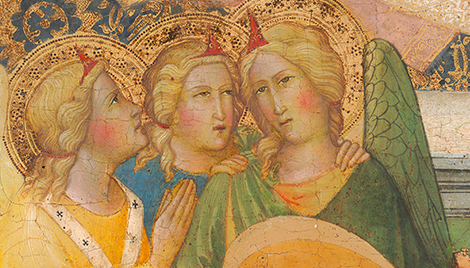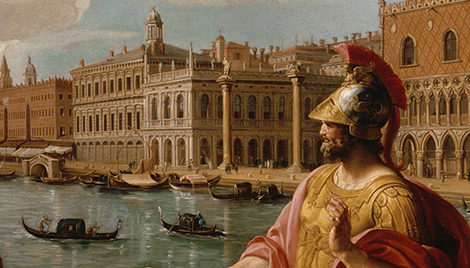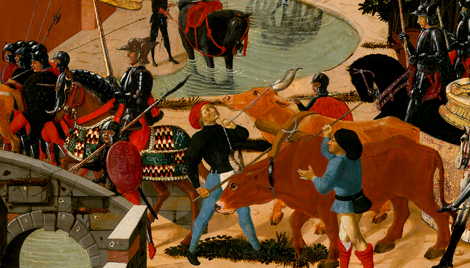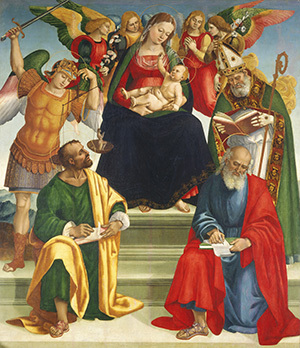Madonna and Child with Saints and Angels
Madonna and Child with Saints and Angels
- Artist
- Luca Signorelli
- Artist Dates
- 1445/1450-1523
- Artist Nationality
- Italian
- Title
- Madonna and Child with Saints and Angels
- Date
- mid or late 1510s
- Medium
- oil on panel, transferred to hardboard
- Dimensions
- 155.7 x 135.6 cm (61 5/16 x 53 3/8 in)
- K Number
- K1657
- Repository
- National Gallery of Art
- Accession Number
- 1961.9.87
- Notes
Provenance
An Albergotti chapel, possibly the one in the Cathedral of Arezzo, built c. 1517; [1] Marchesi Albergotti, by the 17th century; [2] Francesco Lombardi and Ugo Baldi, Florence, by 1845; [3] (Ludwig Metzger, Florence); acquired 17 May 1875 by Alexander William Crawford Lindsay, 25th earl of Crawford [1812-1880], Villa Palmieri, near Florence; [4] by inheritance to his son, James Ludovic Lindsay, 26th earl of Crawford [1847-1913]; by inheritance to his son, Sir David Alexander Edward Lindsay, 27th earl of Crawford [1871-1940]; by inheritance to his son, Sir David Alexander Robert Lindsay, 28th earl of Crawford [1900-1975], Haigh Hall, Wigan, Manchester; [5] (his sale, Christie, Manson & Woods, London, 11 October 1946, no. 152); (Koetser, London and New York). (Wildenstein & Co., Inc., New York); sold June 1949 to the Samuel H. Kress Foundation, New York; [6] gift 1952 to the Honolulu Academy of Arts; returned 1960 to the Samuel H. Kress Foundation; gift 1961 to NGA. [1] The Albergotti chapel of the Duomo, on the left side of the main altar, preserves its original stained glass window, commissioned in 1516 by the canon Baldassare di Luca Albergotti from Guilleaume de Marcillat and executed the following year (see Angelo Pasqui and Ubaldo Pasqui, _Nuova guida di Arezzo e de'suoi contorni_, Arezzo, 1880: 88 n. 59, and Girolamo Mancini, _Guglielmo de Marcillat francese insuperato pittore di Vetri_, Florence, 1909: 25). As such a dating would not seem to contradict the style of the NGA painting, it is quite possible that the latter was executed for the same chapel and in the same time period. Against this hypothesis is, however, the circumstance that the chapel's dedicatee, Saint Sylvester, is not represented on the altarpiece. Among those flanking the Madonna, two figures of evangelists can be recognized, one of whom is probably Mark. Near to one of the Albergotti residences in Arezzo, the "Palazzo delle Statue" in Via Ricasoli, there was a now destroyed church dedicated to this latter saint (San Marco a Murello; see Angelo Tafi, _Guida Storico-Artistica_, Arezzo, 1978: 282), and one cannot exclude that the NGA panel was instead executed for this church. [2] Guido A. Angelucci, _Memori Istoriche per servire di Guida al Forestiero in Arezzo_, Florence, 1819: 83, mentions the modifications made in the 1810s by Bishop Agostino Albergotti to his family chapel in the Cathedral. This work and the construction of a new altar might have caused the removal of the original altarpiece and its transfer to the family gallery. An early twentieth-century photograph in the collections of the Kunsthistorisches Institut in Florence shows, however, the NGA painting in a sumptuous baroque frame bearing the coat-of-arms of the Albergotti. Possibly the panel obtained this new frame when it entered the family gallery; in this case it must have been there by the late seventeenth or early eighteenth century. Oreste Brizi, _Nuova Guida di Arezzo_, Arezzo, 1838: 49, in his description of the Albergotti collection, mentions a painting by Signorelli, but unfortunately fails to specify its subject. [3] See _Collection de tableaux anciens de F. Lombardi and H. Baldi_, Florence, n.d. [1845]: 13. The collection had been formed since 1838; see Denys Sutton, "Aspects of British Collecting-IV," _Apollo_ 122, no. 282 (August 1985): 94. William B. Spence, _The Lions of Florence_, Florence, 1847: 137, states that the private gallery of the restorers and dealers Lombardi and Baldi was one of the most important of its kind in Florence. Although the catalogue of their collection does not give information about the origin of the painting, its provenance from the collection of the marchesi Albergotti is confirmed by Joseph Archer Crowe and Giovanni Battista Cavalcaselle, _A New History of Painting in Italy, from the II to the XVI Century_, 3 vols., London, 1864-1866: 3(1866); Milanesi in Vasari, ed. Milanesi 3, 1878: 701; and Robert Vischer, _Luca Signorelli und die italienische Renaissance_, Leipzig, 1879: 236, 269. [4] Luitpold Dussler, "An Unpublished Signorelli in an English Private Collection," _The Burlington Magazine_ 47 (July 1925): 3, states that the painting was bought by the grandfather of the owner, in Florence. Hugh Brigstocke ("Lord Lindsay as a Collector," _Bulletin of the John Rylands University Library of Manchester_ 64, no. 2 [Spring 1982]: 323 n. 3) reports the existence of a receipt pertaining to the painting's acquisition from Metzger in the archives of the earl of Crawford and Balcarres. The receipt is dated 17 May 1875. An annotation in NGA curatorial files reads as follows: "Mr. Walker [John Walker, NGA Chief Curator and then Director] copied from the Inventory (in old hand) at earl of Crawford's: it was once at the Villa Palmieri and was bought from the heirs of Francesco Lombardi in Florence in 1875 for 1300 fr." It is known that Villa Palmieri was bought by the 25th earl of Crawford in 1873 and sold in 1907 (see Harold Donaldson Eberlein, _Villas of Florence and Tuscany_, Philadelphia and New York, 1922: 346). According to the 1946 sale catalogue, the painting was brought to England in 1905. [5] This location is given by Bernard Berenson, _Italian Pictures of the Renaissance_, Oxford, 1932: 533, and Italian ed., trans. Emilio Cecchi, Milan, 1936: 459, and the 1946 sale catalogue also specifies that this and other paintings of the collection sold at the same auction were "removed from Haigh Hall." [6] The Wildenstein invoice to the Kress Foundation for 16 items, including this painting, is dated 23 June 1949 (copy in NGA curatorial files).






